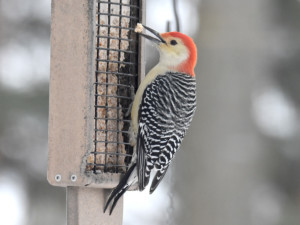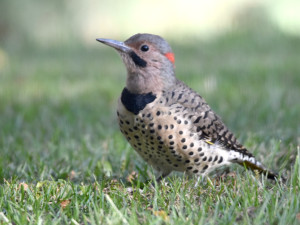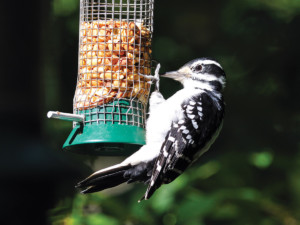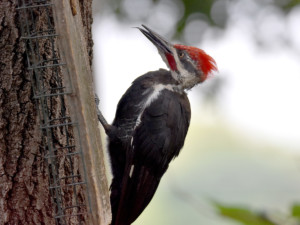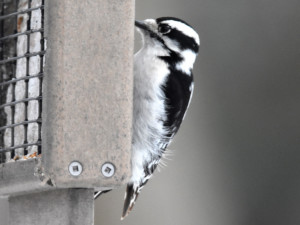The Downy Woodpecker, at about 7”, is the smaller version of the Hairy Woodpecker (I always remember that it’s “downsized”). The males have a small red patch on their back of their heads, females do not. These woodpeckers remain with us all winter and are frequent visitors to our suet and sunflower feeders. Their main diet, however, is insects. Downies love beetle larvae that live inside wood or tree bark, as well as ants, caterpillars, and beetles. About a quarter of their diet consists of plant materials like berries, acorns, and grains.
The Hairy Woodpecker, is the oversized version of the Downy Woodpecker, measuring about 7-10”. Just like the Downy Woodpecker, the males have the red patch on the back of their heads, while the females do not. They also love insects, particularly wood-boring beetles, bark beetles, ants, and moth pupae. About 20% of their diet consists of fruit and seeds. Hairy Woodpeckers are frequently seen at suet feeders and sunflower seeds, especially during the winter months.
The Red-bellied Woodpeckers, at about 9-11”, love insects, including spiders. They also eat plenty of plant material, loving acorns, nuts, pinecones, as well as seeds from annual and perennial plants. They will frequently come to suet, peanut, and sunflower feeders. The males have a red crown and nape. The females’ nape is red, but they lack the red crown.
The Pileated Woodpecker, at about 15-19”, is our largest woodpecker. Pileated males have a red “mustache” and the females do not. Their main diet consists of insects, including ants, beetle larvae, termites, flies, grasshoppers, and cockroaches. The Pileated Woodpecker also enjoys wild fruits and nuts like blackberries, sumac berries, poison ivy, dogwood berries. Ants constitute about 40% of their diet. If you’re lucky, you may also see them at your suet or peanut feeders.
The Northern Flicker is our second largest woodpecker, at about 11-12”. Although some of them migrate further south during the winter, a large number of Northern Flicker overwinter in MN. Flickers eat mostly insects, especially ants and beetles. They do eat fruits and seeds, especially during the winter. Flickers will visit your suet, sunflower, and sometimes even thistle feeders. Females lack the black “mustache” seen on males.
By Guest Contributor MELISSA BLOCK
Also—see our video on identifying Downy vs. Hairy Woodpeckers:



